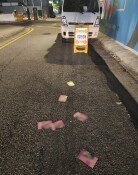Oil Chunks Spread With Currents
Oil Chunks Spread With Currents
Posted January. 04, 2008 03:02,
About 300 residents, government officials, and volunteers with rubber gloves on removed tar chunks stuck on the rocks of the seashore of Muan, South Jeolla Province, on Jan. 3.
The residents expressed frustration on failing to prepare for unexpected tar chunks covering the shore that is 200 km apart from the oil spill area. Muan set up a command control center in the region on the last day of 2007 and is putting all-out effort to clean up the worst oil spill.
Na Sang-pil, 51, the regional government official in charge of oceanic development, said, The amount of tar chunks coming to the shore is decreasing, but we seriously lack volunteers and necessary equipment like rubber gloves.
The damage done on the seaweed farm, one kilometer away from the region, was beyond expectation. Jeong Jong-nam, 54, was devastated to see bamboo sticks and nets for drying seaweeds were covered by tar chunks.
Jeong, who removed soaking paper covered with tar and oil with a scoop net, said, Seaweed farming needs five or six harvesting per week, but I harvested only once last week. I used to make 30-40 million won a year but now it is a pipe dream.
Cho Gye-seok, 60, a member of the fishing village cooperatives who looked around the farming area with Jeong, said with a sigh, Most of the seaweed farms of 240 hectares managed by the cooperatives seem to be damaged. As we should throw away all the equipment tainted with tar, the damage will reach billions of won.
The scope of affected seaweed farms in Yeonggwang, Muan, Shinan, Hampyeong, and Jindo, S. Jeolla Province is around 19,000 hectares. When accurate numbers come out, the damage is expected to be tremendous.
With high strong northwest winds and currents, tar chunks of the west coast are now threatening the southern sea. The first chunk was found in Yeonggwang on Dec. 27 and on Jan. 3, reaching Hwawon peninsula of Haenam. As of now, 17 regions of five counties are affected.
An official of S. Jeolla Province said, Given the fact that tar chunks were found in Hwawon peninsula, they are likely to reach Jeju Island via Uldolmok of Haenam with currents between Jan. 7 and 9. We set up protective oil fences and nets to prevent the attack of chunks to the seaweed farms.
About 3,800 residents, civil servants, and volunteers collected 114 tons of tar on the west coast of S. Jeolla Province. Until now, 326 tons of tar has been collected in the region.
shjung@donga.com



![보아, 25년만에 이별…SM엔터 “자부심이자 상징” [공식]](https://dimg.donga.com/c/138/175/90/1/wps/NEWS/IMAGE/2026/01/12/132096928.2.jpg)



